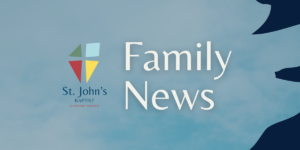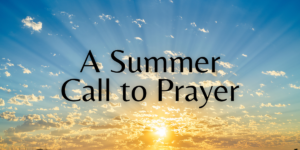The St. John’s Pulpit
March 6 – Fourth Sunday in Lent
Proclaimer: Rev. Martha Kearse
Worship Theme: Imitating the Spiritual Life of Jesus: What Jesus Wouldn’t Do
Sermon: Sanctuary
Scripture: Isaiah 43:1-7,18-19; Acts 10:23b-40a
Back in the age of reading, many of us read (or were required to read) the actual book called The Hunchback of Notre Dame, by Victor Hugo. Despite the efforts of the Disney company, the story of Quasimodo, La Esmerelda, Frollo and Phoebus is not a children’s story, although it contains many of the evils which haunt children as well as adults. Let me tell you the main events of the story as it was originally written:
First, Frollo did find a baby with a severe deformity—he found the child on the Sunday after Easter, which was known as Quasimodo Sunday because the Latin version of the verse used for that Sunday, 1 Peter 2:2, begins with the phrase which means “In this manner,” Quasimodo. It does not mean “half-formed,” by the way, as you might have heard.
The story is that this child, who has a horribly curved spine and a disfigured face, grows up in the Cathedral de Notre-Dame in Paris, where he is the bell ringer—a profession which costs him his hearing. During the Feast of Fools, he is crowned Pope of Fools, and paraded through the streets. Frollo, his guardian, comes across the revels and brings Quasimodo home, but they do not make it home before they run into the beautiful Gypsy woman, La Esmerelda, in the street. When Quasimodo tries to kidnap Esmerelda, he (and the shady figure with him) are stopped by the Captain of the Guard, Phoebus. From this event come all of the following events of the story—Phoebus arrests Quasimodo, who is tried and sentenced to a severe, public beating; Esmerelda expresses compassion toward Quasimodo, and brings him a drink of water while he is one display on the public pillory; when she does this, she is recognized by an old woman, who accuses her of witchcraft.
The story of this novel is a story of insiders and outsiders: Frollo, the clergyman, and Phoebus, Captain of the Guard, are the insiders, the privileged ones. Both of these men fall in love with Esmerelda—a love which ultimately leads to her torture and death. Quasimodo, the hunchback, is an outsider because of his deformity and his deafness; Esmerelda is an outsider because of her association with people called “Gypsies.” Follow this next series of events carefully, now:
Frollo proposes marriage to Esmerelda—she rejects him.
Esmerelda and Phoebus fall in love and agree to meet.
Frollo finds out, and interrupts the meeting, stabbing Phoebus several times.
Esmerelda is arrested as a witch after the attempted murder of Phoebus. She is tortured, and confesses to being a witch. Frollo again offers marriage to save her, but she rejects him.
At the gallows, just as Esmerelda is being prepared to be hung as a witch, Quasimodo—who has also been in love with Esmerelda–swoops in on a rope, gathers Esmerelda in his arms, and swings back to the cathedral, calling out the word, “Sanctuary!” Hugo describes the situation at this point in this way:
“In fact, within the bounds of Notre-Dame, the condemned girl could not be touched. The cathedral was a place of refuge. All temporal jurisdiction expired upon its threshold.”
In the end, the fear of witchcraft wins out over the fear of the power of sanctuary. Guards rush into the cathedral, breaking the laws of sanctuary, and arrest and hang Esmerelda. Quasimodo, who knows that Frollo is behind the attack on the cathedral, breaks Frollo’s neck and throws him off the top of Notre-Dame. Quasimodo looks out over the bodies of Frollo and Esmerelda and cries, “Here is everything I have ever loved!” Years later, Hugo writes, the grave of Esmerelda was uncovered, and her body was entangled with the skeleton of a large man with a horribly curved spine.
That word, “Sanctuary,” is a powerful word in this story. Quasimodo has been offered sanctuary in the cathedral his whole life. A child with such serious physical problems might not have survived in that time, and in that place—for any number of reasons. Quasimodo is well aware of the power of that place, the power of invoking sanctuary for Esmerelda. The place itself is designed to show power—the tallest building in the city, with gargoyles all around to keep evil out, with rose colored lighting from the great stained glass windows inside, to indicate the presence of God. The church, at the time of this story, is equal in power to the secular government, and on the ground sanctified by the church for the purpose of worship, the powers of the throne do not dare to interfere—or do so at their peril. In fiction, and in real events in history, the church provided a safe haven for those in conflict with the secular government. Although they could not leave the walls of the church and remain safe, inside those boundaries, no authority could touch them.
It may seem odd to spend this much time explaining what really happened in a story no one talks about much anymore. It may seem even odder if I tell you that what interests me most today about that story is the theme of hospitality. “Hospitality?” you ask. There’s no hospitality in that story! There are no conversations about table cloths, or flower arrangements! There is no discussion of who sits where and how much chicken to buy! What on earth does this have to do with hospitality? I am so glad you asked those insightful questions! It turns out that hospitality, especially as a theological term, involves a great deal more than name tags and a friendly greeting. It turns out that hospitality is one of the overarching themes of the entire Bible, pervading both story and law, Old and New Testaments. What hospitality means is readiness, it means welcome, it means care and it means protection. Hospitality is the relentless inclusion of outsiders into the group—it is the radical, constant invitation to become family with one another, in spite of all impediments that might make that unlikely.
Let me just offer a brief proof that I am not completely off my rocker with that idea. Think through all the people you know in the stories of the Bible. Abraham, Joseph, Moses, David, Samson, Debora, Esther, Rahab, Daniel, Jesus, Peter, Mary, Paul—name me a Biblical character who is a complete insider—he’s lived there all his life, and he’s the firstborn, and he does what is expected all his life, and he achieves greatness and nothing bad happens to him ever. Give up? I can think of one: Solomon—and even he is not the firstborn. The rest are last born, or in exile, or traveling to a land they know not of—they are oppressed or imprisoned or, heaven forbid, female! To be an insider among the Israelites is to be, by your very nature, an outsider. And, again and again, these outsiders are instructed to be kind to the foreigner, take care of the outsider, bring the outsider into the community—why? Because they know what it feels like to be an outsider.
Hospitality means going out of our way to bring outsiders into our cozy little group of misfits and outsiders who have made community together here. In the Old Testament, the law provides for places called “Cities of Refuge.” These were cities where those accused of murder could go to be safe until they could have a fair, impartial trial in their own defense. The concept of sanctuary came along with the building of the great cathedrals—the ground itself was sanctified and the sense of the focused presence of God in that space meant that anyone on that ground was safe, and could not be harmed by anyone as long as they remained on that holy ground.
In our culture, we mostly did not grow up with that concept of the word “sanctuary.” When I was a child, the sanctuary was the worship room. It was a little bit sacred—you didn’t run in it or yell in it. But there was nothing magical about it and you certainly didn’t go there for safety. Some of the children I know (who shall remain nameless) got in more trouble inside that sanctuary than they did at home or in school! The faith of my childhood was, mostly, taught to me without the mysteries of holy ground or sacred places. When I was hungry, and waiting during the interminable period between the end of church services and the time my mother and father stopped talking and took us home for lunch, I was always glad if it had been a communion Sunday. I would go and take the leftover cubes of white bread from the communion plates, wad them into a ball, and sit there on a pew eating my bread ball until it was gone. I preferred not to get caught doing this, but I had not been taught that there was any magic about that bread—I did not spend any time worrying about my immortal soul.
For us, mysteries are things solved by detectives, either through their brilliant rationalization of clues, or through their thorough use of the scientific technologies available to them. Mysteries get solved. But we have lost a great deal in giving up mystery—particularly the mysteries involved the interaction between us as human beings and the workings of a divine being—one we call God. The Isaiah scripture that was read today offers an image of God as a refuge—as a strong defense and one who makes a safe passage through difficult places. And then we have the story of Peter and Cornelius, the Gentile. Interestingly, in that story, Peter is as much of an outsider in Cornelius’ house as Cornelius is in Peter’s world. By the world’s standards, neither should ever speak to the other or regard the other in any way. And yet, several miracles occur that lead to their meeting and to yet another Biblical passage which entails an expectation from God that we treat each other with radical welcome, genuine kindness, and excessive hospitality.
And here is the kicker—the key to how the whole thing is supposed to work if we’re doing it correctly. In the Temple, as in the Tabernacle, there were several areas—an outer area for foreigners and women, an inner area for men, a smaller inside area for the priests to perform sacrifices and a Holy of Holies—set apart with a curtain—the symbolic seat of God. Even the priests only went in there once a year, because it was so holy. This small room contained the Arc of the Covenant, in which the laws of Moses had been carried around while the people journeyed through the wilderness—the Arc itself a box outfitted with an empty seat, to represent the place where God sits. This symbol of the presence of God with the people of Israel is what made the place holy, just as the sanctification of the cathedral ground by a priest made the cathedral holy. And then there’s this:
1 Corinthians 6:19-20 [Full Chapter]
Or do you not know that your body is a temple of the Holy Spirit within you, which you have from God, and that you are not your own? For you were bought with a price; therefore glorify God in your body.
I know you’ve heard that phrase before, if not the whole verse. You’ve heard “treat your body like a temple,” and if you’re like me, you heard it in the context of “Take care of your body—it’s a temple.” It meant don’t smoke, don’t eat too many Twinkies, don’t do things with your body that profane its sacredness. And that’s all fine, except that if that’s all there is to it, those are some low dad-gummed expectations. What if, when we thought about this room, all we said was, “Hey—don’t smoke in there!” What if the only thing we used this room for was a place where we didn’t throw thrash or play basketball? If the body is a temple of the Holy Spirit within you, I think “Don’t abuse it” would be an understood minimum requirement, and from there we would take on the task of the call to carry the presence of God around with us every day.
Do you see? Do you see it now? If the holy place is the place of refuge, the safe place for the outsider, if the holy place, the temple, is the place sanctified, the place where God resides, and if, as Paul says, our bodies ARE the temple, then we, ourselves, we are the sanctuaries! We become that safe place for the foreigner, the safe place for the bullied, the different, the improper, the incorrect. If our bodies are the temples of God, then we are the ones called on to offer sanctuary to those most in need of refuge. And here’s the great part about each of us as holy places, sanctuaries of a living God—unlike this place, unlike the Temple at Jerusalem or Notre-Dame Cathedral, we are mobile! We move! We can offer sanctuary on the go! We become the walking embodiment of the Arc of the Covenant, carrying within ourselves the presence of God, the holiness of God, the loving kindness of God, and the radical, boundless, imperturbable hospitality of God.
Think of what that means—it’s daunting, to say the least. In our culture, hospitality means fixing a nice meal and making sure the bathroom’s clean before company comes. Those are good things, and, incidentally, they are things many people get by most of their lives allowing others to do for them–I’m just saying it wouldn’t hurt you heterosexual guys to clean a bathroom every once in a while. But in the house of God, hospitality goes way beyond that. Hospitality provides refuge—to the point of standing at the door like Gandalf on the Bridge of Khazad Dum, and saying to anyone who would hurt your refugee, “You shall not pass!” Hospitality is aware of the outsider—ready for the outsider. Hospitality invites the outsider, possibly even before the outsider considers the possibility that he or she might be welcomed. And Hospitality does not care about your sex or your race or your sexual identity or how many tattoos you have or whether you went to the right schools—hospitality doesn’t care what you do for a living, or whether you have decent social skills or how clean your clothes are. Hospitality shows up at your house with a casserole no matter who you are and dares anyone to harm you while you are under her care.
So here is my challenge for you today. Children of God, you are, each one of you, the bearers of the presence of God. Where are those of you still in school? Children and young people, I challenge you this week to be the walking, breathing presence of God in your school, keeping your eyes open for the person who has no one to sit with, the person who is odd, or awkward, the person made vulnerable by disability or learning disorder or poverty or anything else in the million different things that can make someone an outsider in school. I challenge you to find that person and offer welcome to that person—offer kindness, offer friendship, offer your Twinkie. I challenge you to stand up to the bullies in your school—to find the words to stand up against racism, against hate speech of all kinds, against mean-spirited humor. I challenge you to be brave and to offer sanctuary wherever it is needed on your own school grounds. I guarantee you that the need is there, and I guarantee you that the presence of God within you will take care of everything you need—your job is simply to remember that you are the sanctuary, and God will work through you to be that sanctuary.
And to the rest of you—those of you working in jobs, those of you working as parents, those of you retired and working endless hours around here or at other places of services—I offer you the very same challenge. There are refugees everywhere—outsiders are one things we never run out of. There are outsiders in this very room—people who don’t know what circle within our community to belong to, people who have never been asked to anyone’s house for dinner or to join the group at lunch. Dennis has been exploring, in his Lenten series, ideas about things Jesus would not do. I think that’s a more interesting question than “What Would Jesus Do?” Personally, I’ve always preferred the question, “What DID Jesus Do?” because, while I cannot always extrapolate in a given moment what Jesus might do—say for example when a girl at a church basketball team elbows my daughter in the mouth and the ref calls the foul on my girl—but I can look and find out, fairly specifically, what Jesus DID do. And through that negative lens which Dennis is using, it is possible to say that Jesus never looked at anyone and said, “Everybody but you.” Foreigners approached him and he welcomed them. Women approached him, and he welcomed them. Children approached them, and he welcomed them. Lepers and tax collectors and Gentiles and adulterers and short people and tall people—they all tried to access the great love he was giving out. And, not only did he not reject a single person, he went out to meet them. He went looking for them.
What he modeled for us was this: you, me, every single person in this room—every single person we will encounter this week—everyone of us is a sanctuary. Robert Klein used to say, “My wife treats her body like a temple; I treat mine like a pool hall.” Our bodies are not pool halls—they are not banks, they are not malls, they are not parks, they are not movie theaters—we, the people of God are movable Temples, bearing within this strange and wonderful skin the sacred, strong, protective presence of God. Our challenge this week is to remember that.
Amen









